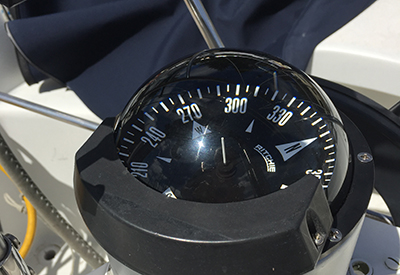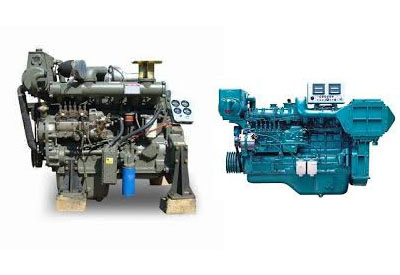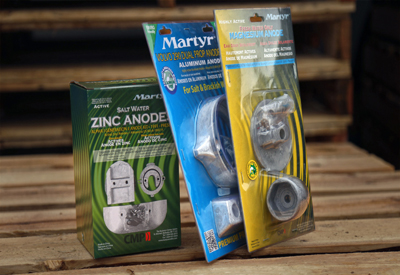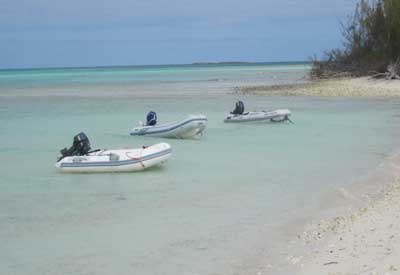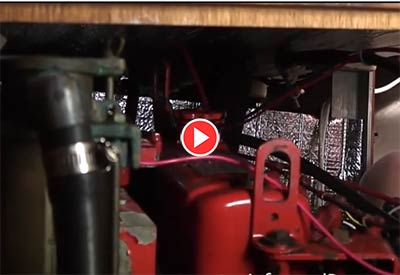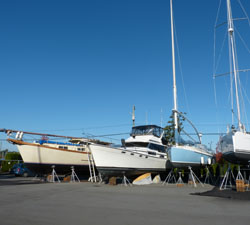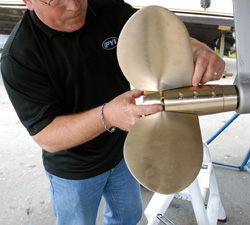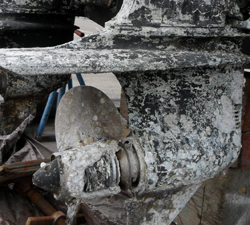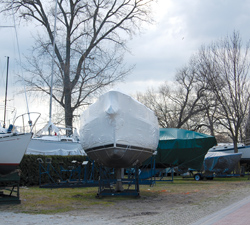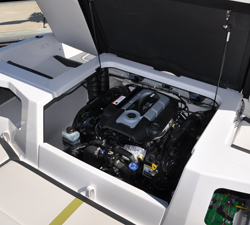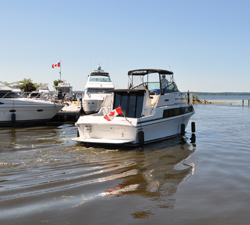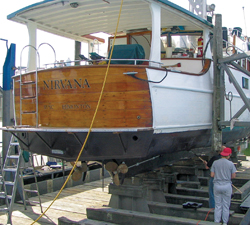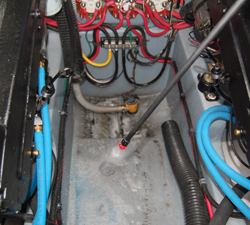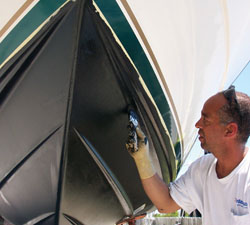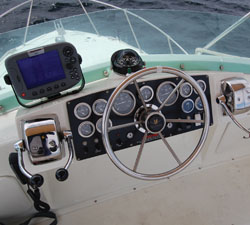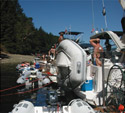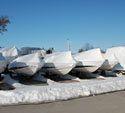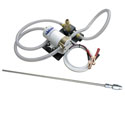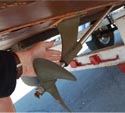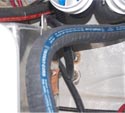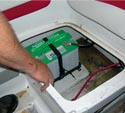February 11, 2020
Marine Diesel Engine Theory and Maintenance Course in March
This one-day course is designed to provide you with a basic understanding of how your Marine Diesel engine operates and how it should be maintained. The course consists of both theory and practical demonstration sessions.
December 18, 2019
Keeping a good boat in good repair.
The boat was put on the hard for this winter and were going to follow along with Graham as he repairs and upgrades the sailboat that has provided many memories and years of comfortable safe boating.
September 30, 2019
Your Compass – The Most Reliable Instrument on Your Boat
I remember vividly my first experience using a chart plotter and navigation system. Deciding that we should try the cruising lifestyle, we purchased an older boat and set out from Hindson’s Marina in Penetanguishene at dawn to sail across Nottawasaga Bay to Thornbury, Ontario for the Canada Day long weekend.
September 10, 2019
Inflatable Boat Repair Course November 4 – 8th, Vancouver
The West Coast Boatyard Association has put together a 5-day inflatable repair course led by the professionals at Zodiac MilPro in Delta, BC this November. Space is limited and registration is only offered through WCBA.
June 5, 2019
Gasoline Containing Ethanol Can Disable Your Engine
For many years now, we have used gasoline in our cars and trucks that contains some amount of ethanol, a form of alcohol, and just as a few drops of water combine almost instantly in your Scotch, moisture from the atmosphere can combine with the ethanol in the gasoline that is in your boat’s fuel tank.
January 8, 2019
Marine Diesel Engine Theory and Maintenance Course
This one-day Marine Diesel Engine course is designed to provide you with a basic understanding of how your Marine Diesel engine operates and how it should be maintained.
March 26, 2018
Time To Sink Zinc
Most of us don’t give a second thought to our sacrificial anodes – those curious knobs of raw metal found on outdrives, shafts, rudders, and other metal components that dangle under the boat.
December 19, 2017
Marine Diesel Engine Theory and Maintenance Course
This one-day course consists of both theory and practical demonstration sessions, is designed to provide you with a basic understanding of how your Marine Diesel engine operates and how it should be maintained.
December 4, 2016
Confident Sailor – Reluctant Sailor – Part 3
Before leaving on an extended cruise, it is critical to inspect and maintain all systems on your boat.
November 4, 2014
Winterizing Your Boat – Oil Change 101
Winterizing your boat in the fall is important and may be a daunting task for some boat owners. This is a DIY project that you CAN do on your own though. Rob MacLeod, The Informed Boater, has put together a how to video with simple step-by-step instructions for completing an oil change, which is a good idea at the end of the season as part of the winterizing process.
March 24, 2014
Smarter Spring Commissioning
Understanding how systems really work – and degrade over the winter – can help you prepare your boat for a trouble-free season. Here’s a guide from a pro…Sometimes the most daunting thing about launching your boat in the spring is slogging through the checklist designed to “help” you do it. And no wonder: commissioning efforts for Canadian boaters run the gamut from paying a full-service yard to re-commission every system on board to putting away the one lonely space heater that’s been wheezing away on the salon floor since Thanksgiving.
November 4, 2013
Folding and Feathering Props
Under sail, these marvels of engineering deliver significantly less drag and greater speed than their traditional fixed-blade cousins. When I started sailing, the economical way to reduce propeller drag on a cruising sailboat was simply to install a two-blade prop. This worked fine – we had one on our 35’ sailboat for almost 30 years. Mind you, it didn’t provide a lot of push in steep seas and headwinds, and we often used the mainsail to help punch us through a chop. Folding and Feathering Props
October 10, 2013
Make New Anodes: Part of Your Haul Out Checklist
When it comes time to haul out this year, plan to give all your underwater gear a close inspection, measure and replace your anodes now and know you are ready for next season. In the fall, you can do this at your leisure. Understandably, we seem to be in a rush to launch again each spring and once the boat is in the water, replacing anodes is difficult to say the least!
August 20, 2013
Don’t Do It Yourself!
It’s not just a matter of cost – there are simply lots of people who enjoy puttering around on their boats and doing their own mechanical work. There are many useful tasks that an owners can do to keep their own little ship “shipshape”, however there are some things where we say, don’t do it yourself! Generally, your fuel system is not a DIY item. For safety reasons alone, a boat’s electrical wiring and grounding systems should always be handled by a qualified marine technician. But, there are other areas where home handyman knowledge can get you into trouble.
August 2, 2013
Ten Winter Storage Dangers
A few people winterize and store their own boat. Many of us pay the pros to do it. Spring commissioning is far more rewarding because you are preparing for a great summer with your boat. Winterizing is a tough chore because we usually keep boating until the weather turns nasty, plus you are struggling with that “down-feeling” that the boating season is over. That makes it doubly hard to dig in and do a great job of winterizing and protecting your boat for the winter.
May 14, 2013
Before You Leave the Dock!
So the boating season has finally arrived and since you have been a diligent owner, all your spring outfitting has been carefully attended to. Everything on that spring check list has been duly checked off and your guests are on their way. The coolers are filled with drinks and snacks and you’re looking forward to great day on the water. However, as experience has taught us, we are at our most vulnerable when our guard is down. Routine can lull us into a false sense of security. Now is the time to make sure you have a proper procedure for departure, one that can make the difference between fun on the water and a day of frustration, or worse.
May 13, 2013
Guide to Sewage Discharge Regs
New rules severely restrict where and how salt-water boaters can discharge sewage. Is your boat ready to comply? In May 2012 a significant environmental anniversary slipped by with little fanfare. It was the end of the promised five-year transition period before new sewage discharge regulations for small craft in salt waters, introduced in 2006-07, took full effect. From 2012 onwards all vessels in Canadian waters, fresh and salt, are covered by the same legislation regarding sewage discharge. Salt-water boaters have a bit more flexibility in pump-out options but the basic rules are now the same for fresh and salt water.
April 4, 2013
Fuel Filtration – Once Again, For the Record
There is no end of discussion and debate about the fuel filtration needs of diesel engines. Myths and half-truths abound. So let’s set the record straight. Diesel engines are the most reliable of all internal combustion engines; they are robust and they need only two simple inputs, air and fuel. Properly maintained they will perform well for upwards of 15,000 hours before needing a re-build. By contrast, that is about three times the life of a well-maintained gasoline engine.
April 4, 2013
Spring Commissioning
Even if you are on salt water and your boat can safely stay in the water year-round, are you using it regularly? Metal fittings are corroding all the time, the sun beats down on fibreglass and woodwork, and the rain and damp air all contribute to the slow but inexorable process of deterioration. When engines are used, oil and other lubricants are warmed up, spread around and parts are kept running freely. Air circulates through the interior when you are out and moving. Boats just like to be used more than they like being stored.
November 30, 2012
Winterizing and End-Of-Season Check-List
It was always a bit sad when we “put to bed” our power-boat at the end of the cruising season. Then, one year, our favourite mechanic suggested creating a service program at the end of this season, rather than the beginning of the next one. Price savings could be had, he explained. From then on we regarded the winterizing phase for our boat as a start of the next cruising season, not the end of the current one. What follows are some ideas to make this as easy as possible — and perhaps even less expensive.
February 10, 2012
Small Efforts Get Big Engine Room Cleaning Results
Putting your boat away with a clean engine room and bilge at the end of the season is extremely important. A coating of oil, or a mixture of oil and fuel, will dry out over the winter and cake onto all of the bilge systems, fasteners and mechanical equipment that it touches. Then, over the winter, the storage wrap traps the oil fumes giving it months to permeate every part of your boat. It also makes the bilge a lot harder to clean out in the spring, but spring is a time when a clean bilge has particular value.
September 7, 2011
Antifouling: More Than One Way To Think Green
Well it’s spring and time to organize most people’s least favourite spring outfitting job. Time to get the bottom painted. These days, when it comes to antifouling paints, we need to consider not just the cost to ourselves, but also the cost to the environment. With a little education, boaters can make both a green and a cost-effective decision for their antifouling paint. First, a little history. From early days, copper in various forms, from copper sheathing to cuprous oxide in paint was the best available biocide for antifouling. Remember TBT (tributyltin).
September 7, 2011
Spring Cleaning the Green Way
Ahhh… The snows have melted (mostly) and spring is in the air. That means it’s time to think about commissioning and getting our boats ready for another summer on the water. Not surprisingly most of us have a bit of work to do on our boats so now is the perfect opportunity to look at cleaning up our act, so to speak. With interest in all things environmental sweeping the globe, it’s worth thinking about how we can get our boats ready to go and do our part to keep our waters, and ourselves, healthy.
August 23, 2011
Care and Feeding of Your Control Cables
We’ve all seen it, or worse, had the experience ourselves; an older boat making a less than elegant landing due to sticky throttle cables, or stiff, balky steering. There are lots of older boats out there that get less use than they deserve due to old and uncooperative cables. This is confirmed by the amount of discussion on various chat rooms concerning the problems associated with cables. Assuming your engine is in good working order, your steering and control cables are the next most important systems on your boat. Yet so often we see boats where these cables are poorly installed or corroded.
December 22, 2010
Winterizing Tips for Your Diesel Engine
Just this past winter, my own transmission cooler, which should have been mounted in a more upright position, froze and split the casing, causing water to steadily leak into my bilge until we discovered the problem and corrected it. By “corrected” I mean dump money into replacing a perfectly good transmission cooler just because I thought it was fully drained when it wasn’t.
December 20, 2010
Tenderizing Your Tender – An Easy Way to Get Around!
I’ll never forget what a sad looking boat it was – a flaccid little inflatable with a wood floor, awash in perhaps 6 inches of slimy brown water that was slowly lapping into and out of the engine cover of the fairly new 9.9 Mercury outboard. The Merc’ had been left on its side on the floor. The dinghy was half under the pier and half in the rain, tied loosely at the back of the big boat’s slip, banging against the pilings 24 hours a day.
June 24, 2010
Spring Launch Checklist Avoids Trouble Later
This Spring Launch Checklist is intended to be helpful for owners whose boats have been winterized and stored professionally. This Checklist is to help you launch the summer of 2010 with a boat that is in tip top shape and ready to deliver a season of trouble-free boating enjoyment. If possible, before the dealer takes your boat out of storage, go and inspect it visually for any sign of fluid leaks, damage by water intrusion or wildlife or missing or damaged pieces.
June 15, 2010
Oil Changes for Larger 4-Stroke Outboards
Those beautiful new 4-stroke outboards behind you are a wonderful power plant. Smooth and quiet, powerful and quick, they’ve come a long way from the “old smokies” that thumped along a few decades back. However, as the 4-stroke outboards have evolved, their maintenance has become something many owners feel may be too complicated, or just plain difficult to attempt. Most owners simply drop off the boat at the yard for a haul-out or call “the guy” when the scheduled oil change is due.
November 14, 2009
Protect Your Propeller Shaft
When was the last time you sent your propeller shaft to the machine shop to be checked? How old are your engine mounts? Have you replaced your cutlass bearing recently? Do I sound like your mother? Well, if she were here, she’d be giving you some important advice! Powerboats and sailboats with inboard engines generally have rubber in the engine mounts, packing material in the stuffing box and a cutlass bearing in the propeller strut.
November 14, 2009
Hose Maintenance
Does your boat have hardening of the arteries? Pardon the joke, but few people think in terms of vital arteries on board their boat. Of course, there are several. In some cases, a clogged artery can cause a fire. In others, a burst (or disconnected) artery can sink your ship in minutes.
November 14, 2009
Winterizing Your Boat
Almost every boat in Canada gets “winterized” in the fall and “summerized” in the spring. Here is an easy way to make sure it’s always done properly, to avoid breakdowns and expenses. We suggest that you invest in about two hours of time from the marine technician at your dealership and together, create a winterizing and summerizing checklist.



